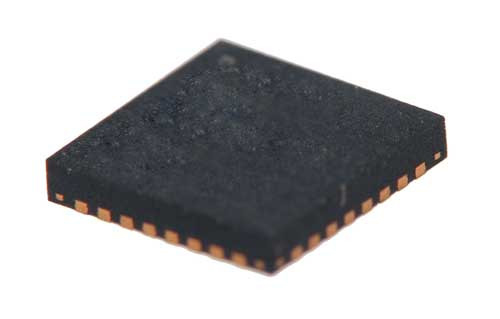ATMEGA88PB-MU
| Manufacturer: | MICROCHIP |
| Architecture: | 8-bit |
| FLASH memory: | 8kB |
| RAM memory: | 1kB |
| EEPROM memory: | 512B |
| Number of I/O: | 27 |
| Supply voltage range: | 1,8V~5,5V |
| Quantity of pcs. | 1+ | 3+ | 10+ | 30+ | 100+ |
|---|---|---|---|---|---|
| Net price (EUR) | 2,3278 | 1,8949 | 1,6442 | 1,5235 | 1,4549 |
| Quantity of pcs. | 6000+ (Need a significantly larger quantity? Ask for price). |
|---|---|
| Net price (EUR) | 1,4549 |
| Manufacturer: | MICROCHIP |
| Architecture: | 8-bit |
| FLASH memory: | 8kB |
| RAM memory: | 1kB |
| EEPROM memory: | 512B |
| Number of I/O: | 27 |
| Supply voltage range: | 1,8V~5,5V |
| Frequency: | 20,000MHz |
| ADC: | YES |
| DAC: | NO |
| UART/USART interface: | YES |
| SPI interface: | YES |
| TWI (I2C) interface: | YES |
| CAN interface: | NO |
| ETHERNET interface: | NO |
| USB interface: | NO |
| Encryption: | NO |
| Operating temperature (range): | -40°C ~ 85°C |
| Case: | QFN32 |
Atmel AVR 8-bit Microcontroller with 8 In-System Programmable Flash ATmega88PB.
Features
• High Performance, Low Power Atmel®AVR® 8-Bit Microcontroller Family
• Advanced RISC Architecture
- 131 Powerful Instructions - Most Single Clock Cycle Execution
- 32 x 8 General Purpose Working Registers
- Fully Static Operation
- Up to 20 MIPS Throughput at 20MHz
- On-chip 2-cycle Multiplier
• High Endurance Non-volatile Memory Segments
- 8 KBytes of In-System Self-Programmable Flash program memory
- 512 Bytes EEPROM
- 1 KBytes Internal SRAM
- Write/Erase Cycles: 10,000 Flash/100,000 EEPROM
- Data retention: 20 years at 85°C/100 years at 25°C
- Optional Boot Code Section with Independent Lock Bits
• In-System Programming by On-chip Boot Program
• True Read-While-Write Operation
- Programming Lock for Software Security
• Atmel® QTouch® library support
- Capacitive touch buttons, sliders and wheels
- QTouch and QMatrix acquisition
- Up to 64 sense channels
• Peripheral Features
- Two 8-bit Timer/Counters with Separate Prescaler and Compare Mode
- 16-bit Timer/Counter with Separate Prescaler, Compare Mode, and Capture Mode
- Real Time Counter with Separate Oscillator
- Six PWM Channels
- 8-channel 10-bit ADC with Temperature Measurement
- Programmable Serial USART with Start of Frame Detection
- Master/Slave SPI Serial Interface
- Byte-oriented 2-wire Serial Interface (Phillips I2C compatible)
- Programmable Watchdog Timer with Separate On-chip Oscillator
- On-chip Analog Comparator
- Interrupt and Wake-up on Pin Change
• 256-channel capacitive touch and proximity sensing
• Special Microcontroller Features
- Power-on Reset and Programmable Brown-out Detection
- Internal Calibrated Oscillator
- External and Internal Interrupt Sources
- Six Sleep Modes: Idle, ADC Noise Reduction, Power-save, Power-down, Standby,and Extended Standby
- Unique Device ID
• I/O and Packages
- 27 Programmable I/O Lines
- 32-lead TQFP and 32-pad VFQFN
• Operating Voltage: 1.8 - 5.5V
• Temperature Range: -40°C to 105°C
• Speed Grade: 0 - 4MHz@1.8 - 5.5V, 0 - 10MHz@2.7 - 5.5.V, 0 - 20MHz @ 4.5 - 5.5V
• Power Consumption at 1MHz, 1.8V, 25°C
- Active Mode: 0.35mA
- Power-down Mode: 0.4pA
- Power-save Mode: <1.0pA (Including 32kHz RTC)
The AVR core combines a rich instruction set with 32 general purpose working registers. All the 32 registers are directly connected to the Arithmetic Logic Unit (ALU), allowing two independent registers to be accessed in one single instruction executed in one clock cycle. The resulting architecture is more code efficient while achieving throughputs up to ten times faster than conventional CISC microcontrollers.
The ATmega88PB provides the following features: 8 Kbytes of In-System Programmable Flash with Read-While-Write capabilities, 512 bytes EEPROM, 1 Kbytes SRAM, 23 general purpose I/O lines, 32 general purpose working registers, three flexible Timer/Counters with compare modes, internal and external interrupts, a serial programmable USART, a byte-oriented 2-wire Serial Interface (I2C), an SPI serial port, a 6-channel 10-bit ADC (8 channels in TQFP and VFQFN packages), a programmable Watchdog Timer with internal Oscillator, and six software selectable power saving modes. The Idle mode stops the CPU while allowing the SRAM, Timer/Counters, USART, 2-wire Serial Interface, SPI port, and interrupt system to continue functioning.
The Power-down mode saves the register contents but freezes the Oscillator, disabling all other chip functions until the next interrupt or hardware reset. In Power-save mode, the asynchronous timer continues to run, allowing the user to maintain a timer base while the rest of the device is sleeping. The ADC Noise Reduction mode stops the CPU and all I/O modules except asynchronous timer and ADC, to minimize switching noise during ADC conversions. In Standby mode, the crystal/resonator Oscillator is running while the rest of the device is sleeping. This allows very fast start-up combined with low power consumption.
Atmel® offers the QTouch® library for embedding capacitive touch buttons, sliders and wheels functionality into AVR® microcontrollers. The patented charge-transfer signal acquisition offers robust sensing and includes fully debounced reporting of touch keys and includes Adjacent Key Suppression® (AKS®) technology for unambiguous detection of key events. The easy-to-use QTouch Composer allows you to explore, develop and debug your own touch applications.
The device is manufactured using Atmel's high density non-volatile memory technology. The On-chip ISP Flash allows the program memory to be reprogrammed In-System through an SPI serial interface, by a conventional non-volatile memory programmer, or by an On-chip Boot program running on the AVR core. The Boot program can use any interface to download the application program in the Application Flash memory. Software in the Boot Flash section will continue to run while the Application Flash section is updated, providing true Read-While-Write operation. By combining an 8-bit RISC CPU with In-System Self-Programmable Flash on a monolithic chip, the Atmel ATmega88PB is a powerful microcontroller that provides a highly flexible and cost effective solution to many embedded control applications.
The ATmega88PB AVR is supported with a full suite of program and system development tools including: C Compilers, Macro Assemblers, Program Debugger/Simulators, In-Circuit Emulators, and Evaluation kits.

